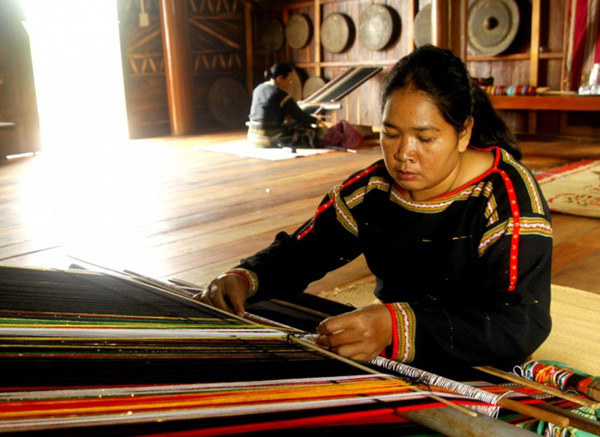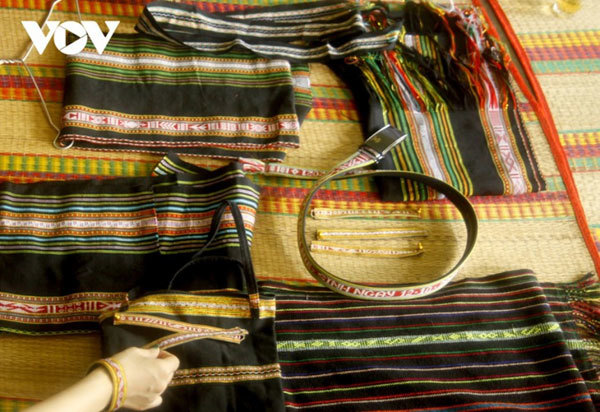 |
| Ede women weave their own clothes and for sale. |
Each design has its own meaning and symbolism, which the Ede have passed down to their offspring by hands-on apprenticeships. The weaver can freely promote their creativity in production.
70-year old H Nun Byă in Cư Êbông Hamlet, Buon Ma Thuot City, has more than 60 years of experience with the looms.
H Nun said when she was little, she saw grandmothers and mothers weave bedding items, baby carriers, and clothes for family use, as dowries for girls, gifts for special occasions, and offerings to bury with the dead.
H Nun said the main colors on the clothes of the Ede are black, red, yellow, and white. The Ede grow cotton plants and collect cotton fibers to spin into strong threads. They dye cotton threads with natural colors extracted from leaves, roots, and barks. Ede women arrange the color threads on looms to weave fabric with intricate patterns.
“In the past people spun cotton fiber into threads and dye. The main colors are white, black, and red. There are many patterns, which normally need 15 to 17 threads to shape or up to 35 threads for special patterns,” said H Nun.
 |
| The patterns on the fabric are specific for different occasions. |
Depending on the occasions, the Ede weave different patterns on specific places of the clothes. Patterns on clothes for men are different from those for women.
Casual and ceremonial wears have specific patterns. Decorations of clothes also show the wealth and power of the wearers.
H Yar Kbuôr, a famous brocade weaver of Ktla Hamlet, said Kteh weaving is considered the pinnacle of the art of decoration on costumes.
In the past, only wealthy families could afford vestments made of the Kteh weaving technique. It is a manual technique combining colored threads and beads to create patterns around the hem of shirts, loincloths, and skirts.
“Kteh technique is used to decorate vestments of noble people and for ceremonies and worshiping. Kteh is the most difficult technique. Even now, not many people can do it well,”
The weaver designs the layout and size of patterns, then choose the yarns they will arrange on the loom. Each pattern needs a certain number of warp and weft yarns and different ways of raising and lowering the yarns.
The weaver mixes colored threads such as red-black, black-yellow, and red-dark indigo to make prominent patterns on the fabric.
H Yam Bkrong, Chairwoman of Tơng Bông Brocade Cooperatives, said Ede women weave images of flowers, leaves, and animals such as birds, turtles, and lizards, and household utensils such as mortals and the stilt houses.
Nowadays, Ede people use mainly industrial threads, but still apply traditional weaving techniques and patterns. They also create new patterns and color combinations to make even more beautiful and attractive fabric.
“The motifs are distinguished between clothes for men and women, such as images of dragons, diamonds, bamboo branches, and turtles. The weavers can freely create their own motifs. For example, we weave bigger patterns by increasing the number of threads used. Besides old patterns, we design new images such as flower vases, people, and houses,” Bkrong said.
Now, brocade costumes have slowly faded from the daily life of the Ede in Dak Lak. But at festivals and important ceremonies, they still wear traditional or modified brocade costumes.
Motifs on their costumes showcase their uniqueness and distinguish them from other ethnic groups.
Source: VOV5



